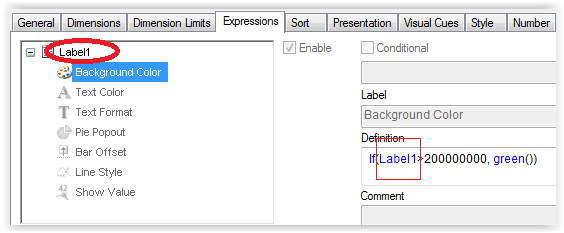Unlock a world of possibilities! Login now and discover the exclusive benefits awaiting you.
- Qlik Community
- :
- All Forums
- :
- QlikView App Dev
- :
- Re: Formulate dimension based on accumulation of e...
- Subscribe to RSS Feed
- Mark Topic as New
- Mark Topic as Read
- Float this Topic for Current User
- Bookmark
- Subscribe
- Mute
- Printer Friendly Page
- Mark as New
- Bookmark
- Subscribe
- Mute
- Subscribe to RSS Feed
- Permalink
- Report Inappropriate Content
Formulate dimension based on accumulation of expression
I have a straight-table graph, with full accumulation in one of the columns.
I am trying to colour the background of the dimension depending on the value of the expression that has been accumulated. I can't seem to be able to do so. If I add an IF statement in the colour expression, I can't reference the accumulated value in the current row, nor can I use Above() or Column() to get expression values. Trying to use these functions gives me an error for that dimension.
Is there any way to base a dimensions (colour, background colour, text format) on the accumulated value of some expression? Is there any way of getting Above() and Column() functions working with a dimension?
Other than loading another column which works out an accumulated value on reload (which would mean the table must have a fixed order for it to make sense) I've got no idea where to go from here.
Here is a QVW to work with. Col1's background colour is currently based on the value of B, but I'd like it to be based on the accumulated value of B (B Accumulated in the table).
Accepted Solutions
- Mark as New
- Bookmark
- Subscribe
- Mute
- Subscribe to RSS Feed
- Permalink
- Report Inappropriate Content
Well, expression like:
=IF(Aggr(RangeSum(Above(Sum(Col2),0,count( total distinct Col1))),Col1)>100,Green(),Red())
PFA, and be careful of sort order as well, because that matters.
- Mark as New
- Bookmark
- Subscribe
- Mute
- Subscribe to RSS Feed
- Permalink
- Report Inappropriate Content
Post you sample app or some data in excell
- Mark as New
- Bookmark
- Subscribe
- Mute
- Subscribe to RSS Feed
- Permalink
- Report Inappropriate Content
Sure, sample added.
- Mark as New
- Bookmark
- Subscribe
- Mute
- Subscribe to RSS Feed
- Permalink
- Report Inappropriate Content
You can refer label of expression in the expression, like:
=If(YourLabel>100, green(), yellow())

- Mark as New
- Bookmark
- Subscribe
- Mute
- Subscribe to RSS Feed
- Permalink
- Report Inappropriate Content
I tried =IF(BAccumulated,..,..) but that didn't work. Is there some special syntax for targeting an expression by it's label?
---
Sorry I replied before your edit. I want to reference the expression value from a dimension, not the expression itself.
- Mark as New
- Bookmark
- Subscribe
- Mute
- Subscribe to RSS Feed
- Permalink
- Report Inappropriate Content
Well, expression like:
=IF(Aggr(RangeSum(Above(Sum(Col2),0,count( total distinct Col1))),Col1)>100,Green(),Red())
PFA, and be careful of sort order as well, because that matters.
- Mark as New
- Bookmark
- Subscribe
- Mute
- Subscribe to RSS Feed
- Permalink
- Report Inappropriate Content
Hi, this works really well, thanks!
Do I have to aggregate in order of A? Can I change the order of the aggregation?
Thanks again.
- Mark as New
- Bookmark
- Subscribe
- Mute
- Subscribe to RSS Feed
- Permalink
- Report Inappropriate Content
If you change the sort order to Z->A, you have to use Below() ins tead of Above(), like:
IF(Aggr(RangeSum(Below(Sum(Col2),0,count( total distinct Col1))),Col1)>100,Green(),Red())